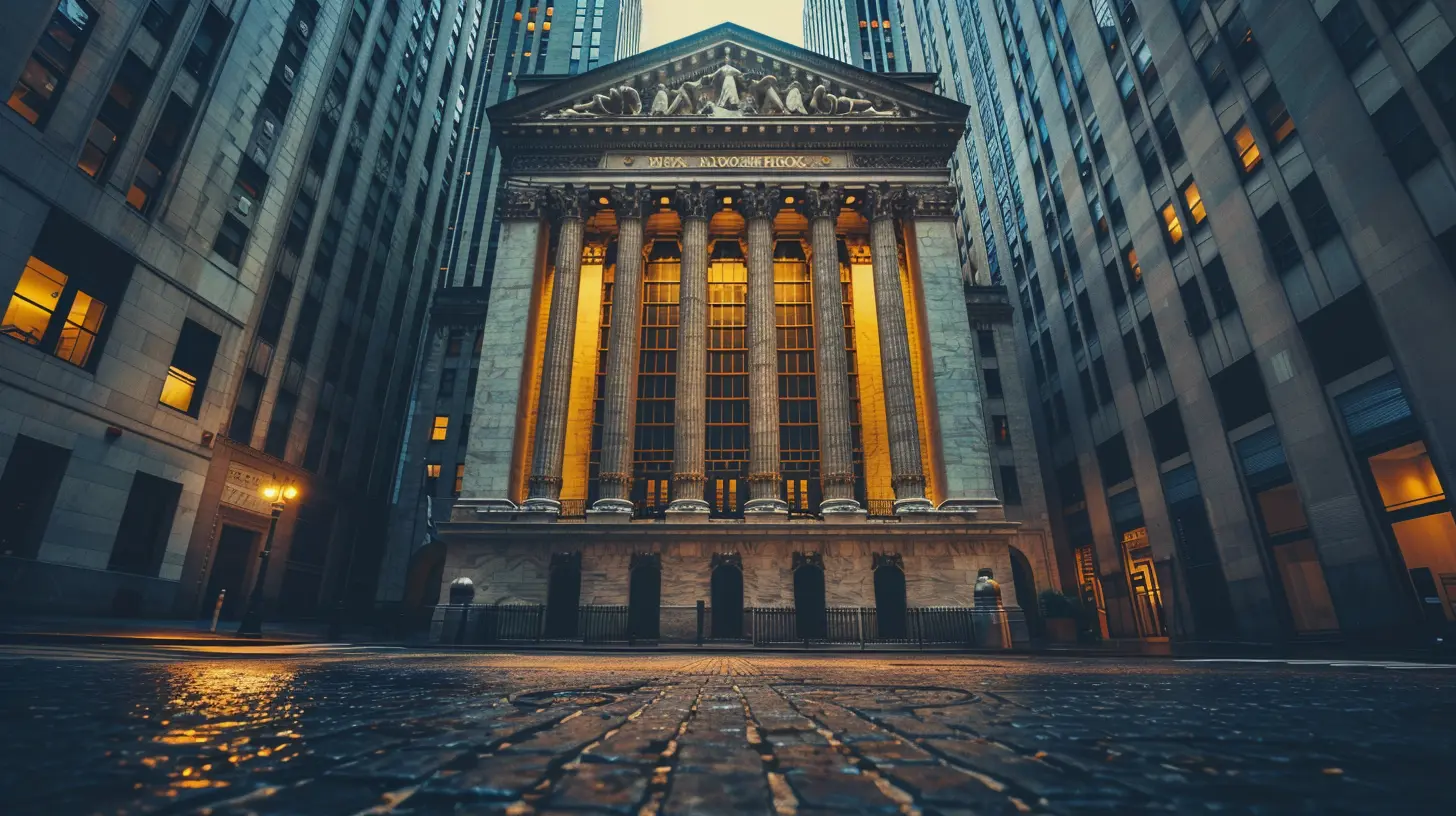Exploring Systemic Risk and Its Impact on Financial Institutions
12 July 2025
Let’s face it—finance can seem a bit like a mysterious machine. Lots of moving parts, flashing lights, jargon that sounds like alien speak. But here’s the thing: when something goes wrong in one part of that machine, it can send shockwaves throughout the entire system. That’s what we call systemic risk.
This isn’t just some stuffy economic term you read in textbooks. Oh no, systemic risk is very real, very powerful, and can make or break entire nations. So, buckle up—because we’re diving deep into what systemic risk is, how it sneaks up on us, and what it means for financial institutions and the everyday person (aka you and me).
What Is Systemic Risk, Anyway?
Let’s break it down. Imagine your financial system as a giant spider web. Everything is connected—banks, lenders, insurance companies, investment firms. Now, if one thread breaks, what happens? The whole web could shake or collapse entirely. That’s systemic risk in a nutshell—it’s the risk of a breakdown in the entire financial system due to the failure of a single institution or group of institutions.It’s not just one bad apple messing things up; it’s that apple spoils the whole barrel.
Sounds scary? It should be. But understanding it is the first step in protecting ourselves from it.
A Trip Down Memory Lane: The 2008 Financial Crisis
You can’t talk about systemic risk without talking about 2008. Remember that mess? Lehman Brothers collapsed, the housing market imploded, and suddenly, confidence in banks vanished overnight. That's systemic risk at full throttle.What kicked it off? A toxic cocktail of subprime mortgages, risky assets, and a lack of regulation. But here’s the key part: the failure of a few major institutions didn’t just hurt them—it sent a domino effect through the entire global economy.
Here’s the thing: people lost homes, jobs, savings. That’s the real impact of systemic risk—it trickles down and hits where it hurts most.
The Ingredients of Systemic Risk
So, what brews up a nice, big pot of systemic risk? Let’s look at the usual suspects:1. Interconnectedness
Financial institutions are tightly linked. They lend to each other, invest together, and engage in complex financial transactions. If one falls, it can trigger a chain reaction.2. Lack of Transparency
Ever try reading a financial statement and feel like you were decoding hieroglyphics? You're not alone. When institutions hide risky positions behind complex financial products, no one really knows what's going on until it's too late.3. Too Big To Fail (TBTF)
Some banks are so ginormous that letting them fail would be catastrophic. Sounds like a safety net? Not quite. These institutions might take on more risk because they assume they'll get bailed out. That moral hazard? Yep—makes systemic risk worse.4. Leverage and Risky Assets
When banks borrow a lot to invest even more, they might see big returns—or suffer massive losses. High leverage is like playing with fire; one wrong move, and it’s game over.5. Poor Regulation
When regulators are asleep at the wheel (or just behind the times), financial institutions can run wild without guardrails. That’s how bubbles grow, and bursts become more brutal.
How Systemic Risk Impacts Financial Institutions
Think systemic risk is just a big-picture problem? Think again. For individual financial institutions, it’s like walking on a tightrope—one wobble from a peer, and down they go too.Here’s how it plays out:
➤ Loss of Trust
In finance, trust is everything. When one big-name player falls, clients and investors start pulling money out of others, even if they’re technically sound.➤ Liquidity Crunches
When confidence drops, so does the willingness to lend. Banks stop lending to each other, creating a vicious cycle of panic and scarcity of credit.➤ Balance Sheet Damage
If one institution takes a hit, others holding the same assets (or those linked to them) also see losses on their books. It’s like a financial flu—contagious and hard to shake.➤ Credit Freezes
Credit stops flowing, not just between banks but to the broader economy—businesses can’t get loans, consumers can’t get mortgages, and growth grinds to a halt.Real People, Real Impact
Let’s bring this home. When banks feel the pressure of systemic risk, it’s not just numbers on spreadsheets. It hits real people like:- Families who can’t get home loans
- Students stuck with high-interest debts
- Entrepreneurs struggling to fund businesses
- Employees facing layoffs as companies tighten their belts
The ripple effect goes far and wide. That’s why tackling systemic risk isn’t just about protecting Wall Street—it’s about shielding Main Street.
Who’s Keeping Watch?
Luckily, systemic risk isn’t flying completely under the radar. There are watchdogs in place to keep an eye out:- Central Banks: Institutions like the Federal Reserve monitor systemic risk and intervene when needed.
- Financial Stability Oversight Councils: They assess risks across sectors and recommend preventive measures.
- Basel Committees & Global Regulators: They set international banking standards to shore up defenses against global financial threats.
But here’s the million-dollar question: Are they doing enough?
How Financial Institutions Manage Systemic Risk
The good news? Financial institutions aren’t just sitting ducks. They’re building shields, too.✔ Diversification
Spreading investments across sectors and geographies helps reduce exposure to single points of failure.✔ Stress Testing
What if interest rates spike? What if a big client defaults? Banks run these “what if” scenarios regularly to test their durability.✔ Liquidity Buffers
Keeping a rainy-day fund—or in financial lingo, maintaining adequate liquidity—helps survive shocks.✔ Improved Transparency
Clear reporting and transparent asset classifications build confidence and help regulators intervene early.✔ Regulatory Compliance
Most institutions now work closely with regulators to stick to risk ceilings and avoid reckless behavior.It’s like wearing a seatbelt—not sexy, but smart when you hit a bump in the road.
Technology’s Role in Tackling Systemic Risk
We often think of tech as the wild west of finance—crypto, AI-based trading, fintech apps. But here's the twist: technology can also help us fight systemic risk.- Big Data Analytics: Spot patterns, identify red flags, and predict where risk might snowball.
- Blockchain: Boosts transparency and reduces the risk of fraud.
- AI & Machine Learning: Algorithms can stress-test multiple scenarios faster than any human team.
Of course, tech brings new risks, too (think cyberattacks or digital bank runs), but when used right, it's a powerful shield.
Is Systemic Risk Inevitable?
Here’s the uncomfortable truth: systemic risk will never vanish completely. Just like you can’t predict when a storm might hit, you can’t predict every financial shock. But we can prepare better.It’s like building a house in a hurricane zone. You know the risk is there—so you build with stronger materials, better designs, and a solid evacuation plan. The same goes for financial systems.
Final Thoughts: Staying Ahead of the Curve
So, what's the takeaway here?Systemic risk is a complex, tricky beast. But it's not unbeatable. The goal isn’t to eliminate all risk (spoiler alert: that’s impossible). It’s about being smart—identifying vulnerabilities, staying transparent, and having mechanisms in place to prevent the worst-case scenario.
For us as individuals? Stay informed. Understand where your money is, how it's being used, and what safety nets are (or aren't) in place.
Because at the end of the day, the financial system isn’t just for suits and skyscrapers. It’s what funds your dreams, your future, your peace of mind. And that’s worth protecting, don’t you think?
all images in this post were generated using AI tools
Category:
Risk ManagementAuthor:

Julia Phillips
Discussion
rate this article
1 comments
Rook Hall
This insightful article effectively highlights the critical relationship between systemic risk and financial institutions, underscoring the importance of proactive risk management.
August 4, 2025 at 3:41 AM

Julia Phillips
Thank you for your thoughtful comment! I'm glad you found the article insightful. Proactive risk management is indeed vital for maintaining stability in our financial systems.


